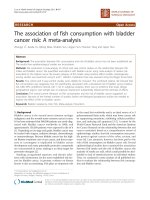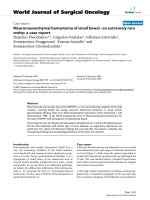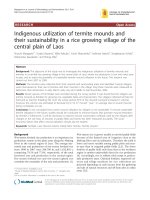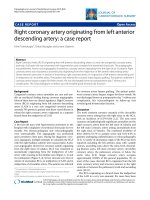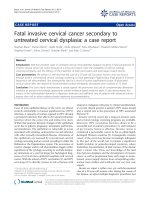Báo cáo y học: " Suspected association of ventricular arrhythmia with air pollution in a motorbike rider: a case report" pptx
Bạn đang xem bản rút gọn của tài liệu. Xem và tải ngay bản đầy đủ của tài liệu tại đây (193.42 KB, 3 trang )
BioMed Central
Page 1 of 3
(page number not for citation purposes)
Journal of Medical Case Reports
Open Access
Case report
Suspected association of ventricular arrhythmia with air pollution in
a motorbike rider: a case report
Kent Emilsson
Address: Department of Clinical Physiology, Örebro University Hospital, SE-701 85 Örebro, Sweden
Email: Kent Emilsson -
Abstract
Introduction: Premature ventricular complexes are to some extent a normal finding in healthy
individuals and the prevalence increases with age and is more common in men. Premature
ventricular complexes can occur in association with a variety of stimuli, and a lesser known cause
is the association between air pollution and ventricular arrhythmias.
Case presentation: A previously healthy man started to ride a lightweight motorbike in heavy
traffic. A few weeks later he was admitted to hospital with premature ventricular complexes in
bigeminy, which decreased after a few days when he was not exposed to exhaust fumes. A few
weeks later he started using the motorbike again and the same symptoms developed once more,
only to subside when he stopped riding in heavy traffic.
Conclusion: Studies have shown an association between air pollution and premature ventricular
complexes and other kinds of arrhythmias. The mechanism may be changes in cardiac autonomic
function, including heart rate and heart rate variability. Air pollution should be considered when
patients present with arrhythmias and no other causes are found.
Introduction
To some extent premature ventricular complexes (PVCs)
are a normal finding in healthy individuals and the prev-
alence increases with age and is more common in men.
However, PVCs can occur in association with a variety of
stimuli and can be produced by direct mechanical, electri-
cal and chemical stimulation of the myocardium. Often
they are noted in patients with false tendons, ischaemic or
inflamed myocardium and during infection, hypoxia,
anaesthesia or surgery. They can be provoked by a variety
of medications, by electrolyte imbalance, by tension
states, by myocardial stretch and by excessive use of
tobacco, caffeine or alcohol [1]. A cause of PVCs that is
not so well known among physicians is the association
between air pollution and ventricular arrhythmias.
Case presentation
A 43-year-old previously healthy man, a physician, living
in a city of about 150,000 inhabitants, began to use a
lightweight motorbike to commute to work, a distance of
about 10 km, in heavy traffic in the middle of August
2006. He had previously been travelling in a car fitted
with an air pollution filter, and had experienced no previ-
ous heart symptoms. He also walked or jogged about 6
km four to five times a week with no problems and was
not on any medication. He felt relaxed and did not expe-
rience stress while riding the motorbike in heavy traffic.
There were numerous traffic lights on his journey to work,
which meant that he was forced to stop behind buses and
trucks on several occasions where he experienced a strong
smell of exhaust fumes.
Published: 3 June 2008
Journal of Medical Case Reports 2008, 2:192 doi:10.1186/1752-1947-2-192
Received: 14 November 2007
Accepted: 3 June 2008
This article is available from: />© 2008 Emilsson; licensee BioMed Central Ltd.
This is an Open Access article distributed under the terms of the Creative Commons Attribution License ( />),
which permits unrestricted use, distribution, and reproduction in any medium, provided the original work is properly cited.
Journal of Medical Case Reports 2008, 2:192 />Page 2 of 3
(page number not for citation purposes)
After commuting to and from work by motorbike for
about 2 weeks he began experiencing cardiac extrasysto-
les, something not previously experienced; on one occa-
sion he was unable to sleep due to palpitations. He sought
help and had an electrocardiogram (ECG) the following
morning, which showed PVCs in bigeminy. The patient
had also sinus tachycardia with a heart rate of about 110
beats per minute.
The patient was admitted to the cardiac intensive care unit
and was examined using echocardiography, which was
found to be normal, and there were no signs of false ten-
dons. No ischaemia was seen on ECG and there were no
signs of infarction. The frequency of PVCs began to
decrease about 8 hours after admission. Blood tests
showed no indications of infarction or infection, his
blood glucose was normal and his lipid status and thyroid
status were within normal limits. The patient had no
fever. During the night and the next morning only a few
PVCs and some premature atrial complexes were observed
and the patient was discharged home. The diagnosis was
given as myocarditis, although this diagnosis was uncer-
tain.
The patient rested for 2 weeks with no further symptoms
before returning to work. For the first few weeks he drove
his car to work, but then began to use his motorbike
again. Having used it for a few weeks on the same route he
again began to experience extrasystoles and therefore con-
tacted his physician, who recommended an exercise test
and Holter ECG.
In the few days before the Holter ECG was applied the
patient refrained from using his motorbike and began to
feel better. Only a few PVCs and premature atrial com-
plexes were found during 24 hours of Holter monitoring.
The heart rate variability (HRV) showed a pattern with a
somewhat high low-frequency to high-frequency ratio. An
exercise test was carried out and the patient performed
well, with no chest pain, arrhythmias or signs of ischae-
mia.
The patient began to believe that there was an association
between using his motorbike and his symptoms and
decided to stop using it. Since then no symptoms, apart
from an occasional single extrasystole, have been noted by
the patient.
Discussion
In the present case there was no obvious explanation for
the PVCs. Myocarditis was thought to be the underlying
cause, even if this diagnosis was uncertain. This is a condi-
tion with various clinical presentations, from non-specific
symptoms (fever, myalgias, palpitations or exertional dys-
pnoea) to fulminant haemodynamic collapse and sudden
death. Myocarditis is difficult to diagnose and endomyo-
cardial biopsy remains unequivocally the gold standard
for establishing the diagnosis [2], although this cannot
always be used in clinical practice. Cardiac biomarkers,
especially troponin T or I, are now routinely measured by
most clinicians when a clinical diagnosis of myocarditis is
considered [2]. In the present case, however, the cardiac
biomarkers creatine kinase and troponin T were not ele-
vated.
Echocardiography can also help in the diagnosis of myo-
carditis, often showing left ventricular dysfunction and
segment wall abnormalities in patients with biopsy-
proven myocarditis [2]; here, however, the echocardiogra-
phy was also normal. The patient had no obvious signs of
ongoing infection and he had normal laboratory findings.
Thus, myocarditis was an uncertain diagnosis in this case.
There was no electrolyte imbalance and the thyroid status
was normal. There were no signs of ischaemia during the
exercise test. The patient was a non-smoker and did not
drink coffee or use alcohol. Thus, there was no obvious
cause for the PVCs in this case.
A less well-known cause of PVCs is exposure to exhaust
fumes from vehicles. Some studies have shown increased
premature atrial complexes and PVCs in patients with
implanted cardioverter defibrillators when exposed to
high concentrations of air pollutants [3,4]. In addition to
reported associations between PVCs and air pollution,
there are also studies showing the association between air
pollution and atrial fibrillation [5] and supraventricular
extrasystoles and supraventricular tachycardia [6].
Most of the studies so far concerning arrhythmia and air
pollution are on subjects with known heart disease; how-
ever, one study of healthy young non-smoking male high-
way patrol troopers in the United States has shown an
increased number of premature supraventricular beats
and changes in HRV [7].
The mechanism by which air pollution leads to cardiac
morbidity and mortality remains unknown. Hypoxia has
been suggested as a possible cause of air pollution-
induced cardiac damage or vulnerability, but this has
been shown not to be a culprit mechanism [8]. Pope et al.
[9] suggest that it is due to changes in cardiac autonomic
function, reflected by changes in mean heart rate and
HRV. The inhaled environmental particles may promote a
systemic sympathetic stress response, causing the heart
rate to increase, the HRV to decrease and the ratio of low-
frequency to high-frequency to be higher (as in the
present case), causing ventricular tachyarrhythmias and
ventricular fibrillation [8]. In a similar manner the
inhaled particles also stimulate irritant receptors in the
Publish with BioMed Central and every
scientist can read your work free of charge
"BioMed Central will be the most significant development for
disseminating the results of biomedical research in our lifetime."
Sir Paul Nurse, Cancer Research UK
Your research papers will be:
available free of charge to the entire biomedical community
peer reviewed and published immediately upon acceptance
cited in PubMed and archived on PubMed Central
yours — you keep the copyright
Submit your manuscript here:
/>BioMedcentral
Journal of Medical Case Reports 2008, 2:192 />Page 3 of 3
(page number not for citation purposes)
lung parenchyma and respiratory airways, which can lead
to increased bronchoconstriction, increased vagal
responses of the heart, increased HRV and increased high-
frequency domain, possibly leading to bradyarrhythmias
in appropriate settings [8].
A link has been demonstrated between carbon monoxide
from vehicles and ventricular arrhythmias [3,10], but
there are also studies that have shown that carbon mon-
oxide has no significant effect on ventricular electrical sta-
bility or the frequency of ventricular ectopic activity
[11,12].
In the present case it would have been of interest to obtain
an ambulatory ECG during a motorbike ride in order to
report changes in autonomic factors or changes in cardiac
electrical instability in the myocardial substrate (as meas-
ured by T-wave alternans). This could not be done in the
present case but could perhaps be performed in the future
in a similar case. Moreover, while the subject did not
report feeling stressed one cannot exclude the possibility
that noise and stress contributed to the findings, and
measures of cortisol, for instance using salivary cortisol,
would have settled this issue. This was not possible in this
case but may also be performed in the future if a similar
case is noted.
Conclusion
Studies have shown an association between air pollution
and PVCs and other kinds of arrhythmias. The mecha-
nism may be changes in cardiac autonomic function,
including heart rate and HRV. Air pollution should be
considered when patients present with arrhythmias and
no other causes are found.
Abbreviations
ECG; electrocardiogram; HRV: heart rate variability; PVC:
premature ventricular complex.
Competing interests
The author declares that they have no competing interests.
Consent
Written informed consent was obtained from the patient
for publication of this case report and any accompanying
images. A copy of the written consent is available for
review by the Editor-in-Chief of this journal.
Acknowledgements
The author would like to thank Dr Derek Filbey for his linguistic revision
of the manuscript.
References
1. Olgin JE, Zipes DP: Specific arrhythmias: diagnosis and treat-
ment. In Braunwald's Heart Disease: A Textbook of Cardiovascular Med-
icine 7th edition. Edited by: Zipes DP, Libby P, Bonow RO, Braunwald
E. Philadelphia, PA: Elsevier Saunders; 2005:840-841.
2. Magnani JW, Dec GW: Myocarditis: current trends in diagnosis
and treatment. Circulation 2006, 113:876-890.
3. Dockery DW, Luttmann-Gibson H, Rich DQ, Link MS, Schwartz JD,
Gold DR, Koutrakis P, Verrier RL, Mittleman MA: Particulate air
pollution and nonfatal cardiac events. Part II. Association of
air pollution with confirmed arrhythmias recorded by
implanted defibrillators. Res Rep Health Eff Inst 2005, 124:83-126.
4. Rich DQ, Schwartz J, Mittleman MA, Link M, Luttmann-Gibson H,
Catalano PJ, Speizer FE, Dockery DW: Association of short-term
ambient air pollution concentrations and ventricular
arrhythmias. Am J Epidemiol 2005, 161:1123-1132.
5. Rich DQ, Mittleman MA, Link MS, Schwartz J, Luttmann-Gibson H,
Catalano PJ, Speizer FE, Gold DR, Dockery DW: Increased risk of
paroxysmal atrial fibrillation episodes associated with acute
increases in ambient air pollution. Environ Health Perspect 2006,
114:120-123.
6. Berger A, Zareba W, Schneider A, Rückerl R, Ibald-Mulli A, Cyrys J,
Wichmann HE, Peters A: Runs of ventricular and supraventricu-
lar tachycardia triggered by air pollution in patients with
coronary heart disease. J Occup Environ Med 2006, 48:1149-1158.
7. Riediker M, Devlin RB, Griggs TR, Herbst MC, Bromberg PA, Wil-
liams RW, Cascio WE: Cardiovascular effects in patrol officers
are associated with fine particulate matter from brake wear
and engine emissions. Part Fibre Toxicol 2004, 1:2.
8. Stoen PH, Godleski JJ: First steps toward understanding the
pathophysiologic link between air pollution and cardiac mor-
tality. Am Heart J 1999, 138:804-807.
9. Pope CA III, Verrier RL, Lovett EG, Larson AC, Raizenne ME, Kanner
RE, Schwartz J, Villegas M, Gold DR, Dockery DW: Heart rate var-
iability associated with particulate air pollution. Am Heart J
1999, 138:890-899.
10. Dockery DW, Luttmann-Gibson H, Rich DQ, Link MS, Mittleman MA,
Gold DR, Koutrakis P, Schwartz JD, Verrier RL: Association of air
pollution with increased incidence of ventricular tachyar-
rhythmias recorded by implanted cardioverter defibrilla-
tors.
Environ Health Perspect 2005, 113:670-674.
11. Verrier RL, Mills AK, Skornik WA: Acute effects of carbon mon-
oxide on cardiac electrical stability. Res Rep Health Eff Inst 1990,
35:1-14.
12. Dahms TE, Younis LT, Wiens RD, Zarnegar S, Byers SL, Chaitman BR:
Effects of carbon monoxide exposure in patients with docu-
mented cardiac arrhythmias. J Am Coll Cardiol 1993, 21:442-450.
